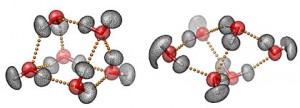July 2011 Alex Roslin, an investigative reporter according to his blog, wrote an article about nanoparticles and safety that was published in a Vancouver (Canada) weekly newspaper called the Georgia Straight. My July 26, 2011 posting featured an analysis and critique of Roslin’s uninformed and, at times, misleading presentation of the facts or, in some cases, nonfacts.While I agree with Roslin and others that safety issues are critical with regard to nanotechnology, I am newly disappointed, as I was in July 2011, with the quality of the information in Roslin’s work.
His latest kick at the nanoparticle can be seen in an Aug. 11, 2012 article for the Montreal Gazette (it has been reproduced in other newspapers). Here’s an example of two misleading comments from Roslin,
If you have Robert Schiestl over to your house, don’t be surprised to see him peeking at ingredient labels on things in your kitchen or bathroom.
He can’t help it. Schiestl, a leading U.S. cancer expert, instinctively reads the label before he buys or uses a host of products — any food that’s partly white, toothpaste, sunscreen, shampoo, over-the-counter medicine.
He’s trying to avoid nanoparticles, which a growing pile of studies say may cause cancer, damage to organs and skin, Crohn’s disease and environmental pollution.
There are naturally occurring nanoparticles, as well as, engineered nanoparticles. Depending on the definition for a nanoparticle, milk could be described as nanoparticle- laden as per the European Union’s definition adopted last year (featured in my Oct. 18, 2011 posting). As for engineered nanoparticles, silver ware sheds silver nanoparticles when you use it to eat (see my Oct. 25, 2011 posting for more information and links). Schiestl is likely to be quite frustrated in his quest.
Roslin’s other misleading comment is about the studies. The studies I’ve seen are disturbing but they subject the computer simulations, cells, tissues or animals to conditions not likely to be encountered by most of us. For example, researchers at the University of Missouri found that nano zinc oxide (used in some sunscreens) could generate free radicals which when exposed to UV rays could kill skin cells. The study used lung cells not skin cells. While the two types of cells are closely related there are some significant differences. After all, when was the last time you slathered sunscreen on your lungs? Also, note the scientists used the verb ‘could’ not ‘would’ as per my May 8, 2012 posting where I have excerpts with direct quotes from the scientists along with more questions about this study.
Let’s take a look at Roslin’s example (from his Aug. 11, 2012 article),
But in a study Schiestl co-authored in the journal Cancer Research in 2009, mice that drank water with titanium dioxide nanoparticles suffered DNA and chromosomal damage, which could lead to cancer.
So drinking titanium dioxide nanoparticles ‘could’ lead to cancer. In what quantity did the mice drink their titanium dioxide nanoparticle-laced cocktails? How saturated was the solution (50%, 2%, 90%) with the titanium dioxide nanoparticles?Is the type of mouse used for this testing problematic? (I dimly recall that some breeds of mice are more susceptible to certain kinds of damage than other breeds.) With these questions I’m trying to demonstrate the difficulty of determining how applicable the study might be when no details are offered so one might better evaluate the information.
I am thankful to find out from Roslin’s article about an article (published in Sept. 2011?) titled, Are consumer products made with nanotechnology worth the risk?, in a National Research Council publication, Dimensions, concerning a June 2011 public forum on nanotechnology and safety,
… Dimensions presents the views of four leading Canadian experts on the science, regulation and risks of nanotechnology. The discussion that follows summarizes an NRC-hosted public forum, entitled “Nanotech: the big controversy of miniature science,” held on June 6, 2011, in Ottawa.
Unusually, there is no information about how many people attended or where this forum was held and I’ve been unable to find any other trace (e.g., a notice about the forum beforehand) of this event online.
Still, the article does offer responses the experts (Dr. Agnes Klein, Dr. Elizabeth Nielsen, Dr. Abedelnasser Abulrob and Pat [Roy] Mooney) gave to a series of questions (from the article),
Key Questions:
- What is you connection with nanotechnology?
- Why is it important for Canada to be competitive in the nanotechnology field?
- What are some of the potential benefits of nanotechnology?
- Are there any concrete examples of specific concerns or risks associated with nanotechnology?
- Are there any examples where the precautionary principle has been applied to consumer products that contain nanoparticles?
- Why should we worry about nanoparticles given that atoms and molecules are much smaller and can pass through our bodies?
- What other issues surrounding nanotechnology should concern us?
I find the questions interesting since there’s at least one that seems to be missing. In public forums people tend *to ask questions about issues of personal concern and nanosunscreens would tend to fall into that category.
There is some interesting and there might even be some valuable information in Roslin’s article but I can’t trust his research or presentation of facts as I’m able to spot too many misrepresentations and errors.
I have a couple examples of good articles on nanotechnology and its safety issues in my July 12, 2012 posting. (Aug.20.12: I’ve made some grammatical changes in the preceding sentence since it was written on Aug.17.12.) The two articles cited offer a comprehensive introduction but if you have time for only one, I strongly recommend Julie Deardorff’s July 10, 2012 article for the Chicago Tribune. She doesn’t pull her punches and she’s done a much better job of researching and presenting the facts.
* The preposition ‘to’ was added to the sentence on Apr. 11, 2013.

